Menu
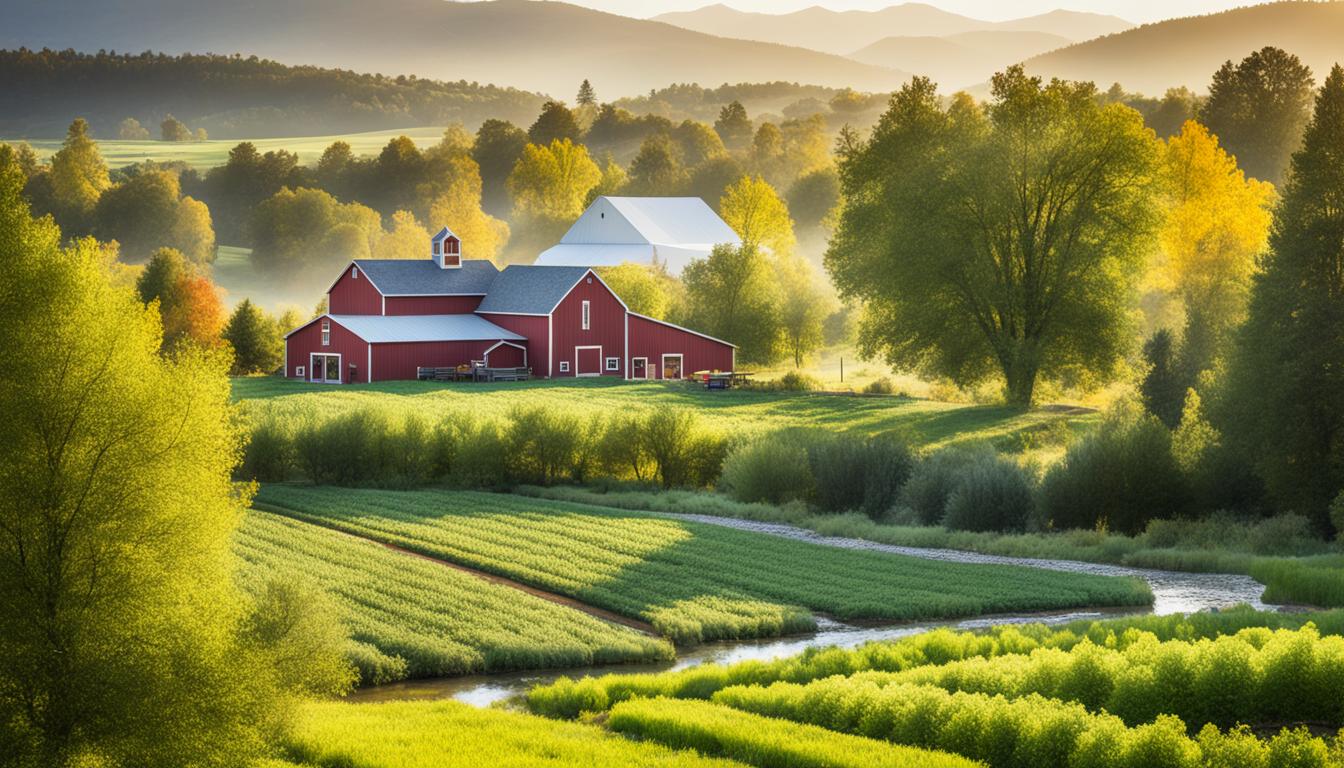
Did you know mixing crops on a farm could mean better harvests without harmful chemicals? Polyculture farming mixes different plant types rather than growing just one. This helps the farm work more like a natural wild space.
Our way involves a mix of techniques. We plant different crops close together, cover the soil with special plants, and change what we plant in a field each year. These choices lead us to sustainable agriculture. We might not always get as much harvest, but we’re doing what’s best for the planet. Less pest sprays, happier soil, and sticking to regenerative agriculture are big parts of this.
Organic polyculture systems are like the opposite of planting just one type of crop. They grow many different crops together. This way of farming, also known as agroecology, creates a strong and balanced ecosystem. This helps natural growth to happen.
Farmers use each plant’s special qualities to improve the overall farm harvest. They do this for good organic crop management. The main methods include:
Using polyculture agriculture makes the soil healthier and the farming system stronger. For example, it has cut down pesticide use by 75%. This happens because there are fewer pests, diseases, and weeds.
| Aspect | Polyculture | Monoculture |
|---|---|---|
| Pesticide Use | 75% Reduction | High Usage |
| Nitrogen Fixation | Higher due to Legumes | Lower |
| Resource Competition | Potential Yield Impact | Less competition |
| Preferred by Farmers | Small-scale, Organic Farmers | Large-scale Farmers |
To sum up, organic polyculture methods support sustainable and eco-friendly farming. They make the soil better and help keep the farming system strong.
Organic polyculture systems have many ecological and agricultural benefits. They enhance ecosystem diversity. This boosts ecological resilience in agriculture. Mixing different plant types in the same area strengthens soil health and water usage.
Polyculture expands biodiversity. It mixes many plant species, benefiting the soil and ecosystem. Plants like legumes improve soil quality by fixing nitrogen. Plus, deep-rooted plants bring up nutrients for those with shallow roots. This helps in sustainable farming by reducing soil erosion and loss of nutrients. When planting crops like corn, beans, and squash together, they save water. This shows how polyculture improves environmental strength through plant teamwork.
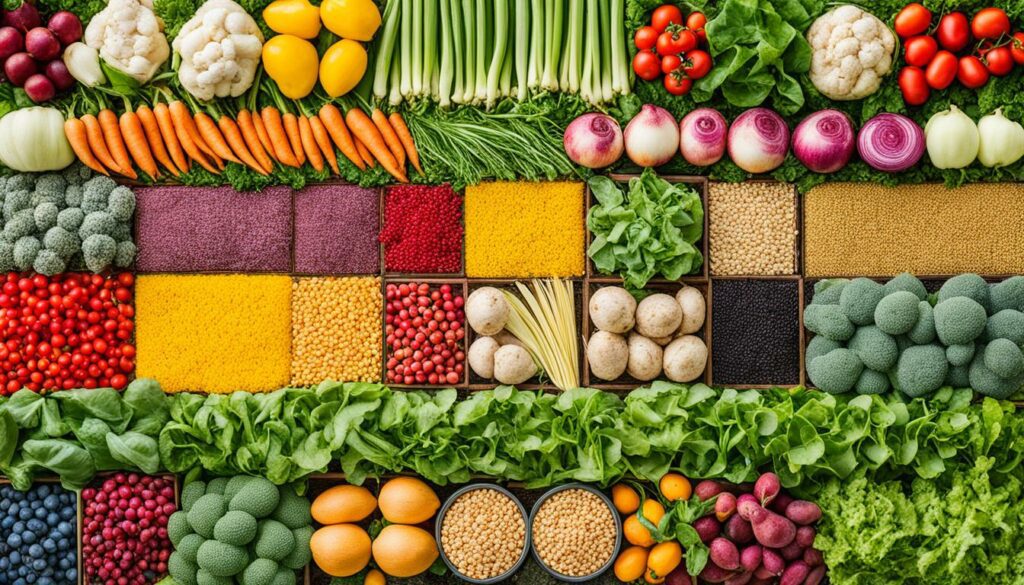
The variety in polyculture gardens naturally keeps pests away. The mix of plants confuses pests, lowering their numbers. This is a strong pest management method. It makes pest outbreaks rare. Polyculture also leads to more gardeners working together. They learn how to control pests without harmful chemicals. This is supported by permaculture, making agriculture more sustainable.
More and more farmers are choosing organic and sustainable farming. Polyculture helps by needing less synthetic chemicals and by improving soil and crops. This is vital for keeping farming ecologically strong and sustainable.
Polyculture farming is a mix of methods that make the most out of land. It raises how much food can be grown. It’s key to combine different crops in a smart way. This way, farmers can use their land well and grow more food.
Multiple cropping means you grow different crops back to back in one season. This uses the land constantly and keeps the soil good for plants. It’s great for getting more crops from the same field in places where the soil isn’t so rich. Studies have shown that using many different crops can give better results than if you only grow one type.
Relay cropping is when crops overlap in growing times. It’s smart because it uses sunlight well and makes better use of land. This is really helpful for farmers with little land. A big plus is that it uses fewer chemicals than growing just one crop.
| Attributes | Multiple Cropping Systems | Relay Cropping |
|---|---|---|
| Land Use Efficiency | High | Very High |
| Yield Improvement | Moderate to High | High |
| Resource Optimization | Optimal | Excellent |
| Implementation Complexity | Medium | High |
Using multiple cropping and relay cropping well can lead us to more sustainable farming. This helps nature, makes better use of resources, and has fewer bad impacts on the environment.
Intercropping is when you grow two or more crops together. This farming method is a key part of organic crop diversification. It makes agriculture more productive and sustainable. In places like Malawi, nearly all farmland uses intercropping. This boosts soil fertility and cuts down on pests.
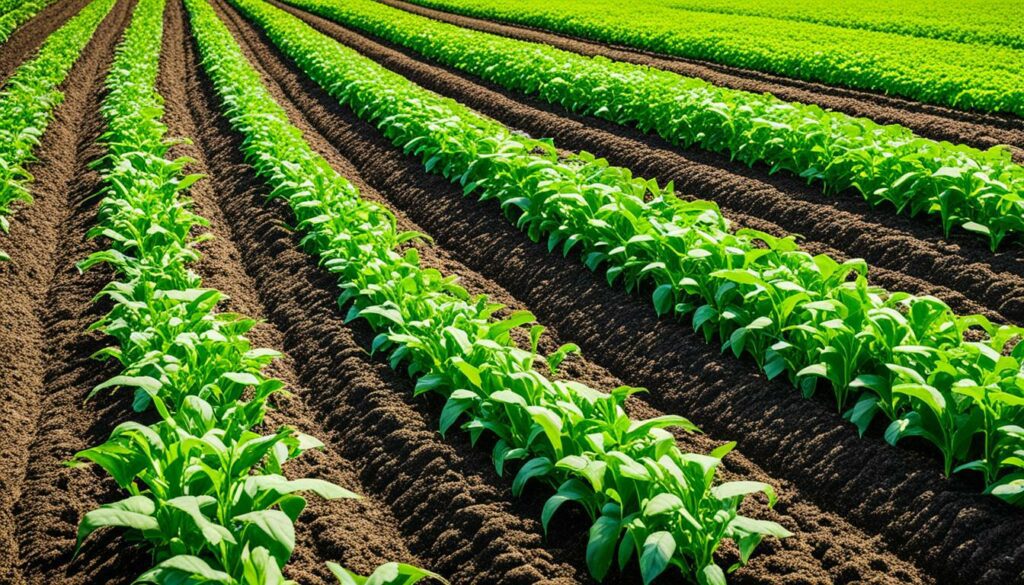
In Africa, most cowpeas (89%) and in Colombia, beans (90%) grow together. This way, farmers use less chemical fertilisers. Why? Because some plants, like legumes, can add nitrogen to the soil. This means more variety in nature and fewer problems with pests and diseases.
Today, many farmers focus on growing just one type of crop – monoculture. But, this can harm the land and make farming less sustainable. By growing different crops together, we can make the soil better and use resources wiser. This is a big step towards a greener way of farming worldwide.
FAO’s 2011 guide on the sustainable intensification of smallholder crop production emphasises the critical role intercropping plays in this endeavour.
Combining crops in traditional ways can give us 15–20% of the world’s food. And, it’s also good for the environment. For example, mixing maize and soybeans has shown better farm results and protects the land. This approach supports food supplies and makes farming kinder to nature.
Intercropping isn’t just about mixing crops. It helps farms work better, especially in places where land is limited.
Cover cropping is key in modern farming. It helps with soil conservation and boosts organic farming. This method involves planting crops on unused land to protect and feed the soil. This keeps the land productive for years to come.
Research has found that planting green manures ahead of main crops can boost yields. It improves the amount of healthy matter in the soil. This helps with soil structure, water holding, and nutrient levels like calcium and potassium.
It also makes the soil life friendlier for plants. And, by storing more carbon, it might help fight climate change. The positive effects of cover crops grow with time. They’re influenced by water, initial soil quality, the types of crops used, and when they’re used.
The Jena Experiment showed that more types of plants led to better soil and more nutrients. These healthy soil features increased over time, helping crops grow better. Another study found that using more than one cover crop leads to a richer soil and higher crop yield.
Legumes and grasses are common as cover crops. They’re then ploughed back to improve the soil. This method naturally boosts soil health and air in the soil. It cuts the need for lots of digging or nitrogen fertilizers. This is good for the environment and the farmer’s effort. Even with different weather and care, cover crops tend to lower water loss from fields.
Historical documents show green manure’s benefits were known over 3,000 years ago in China. In more recent times, American farmers say cover crops increased their harvests. They also saved money on chemicals. Planting cash crops directly into green cover and then stopping growth early has great effects. It controls weeds, keeps soil wet, and lets farmers plant sooner.
A majority of surveyed farmers (52%) practiced “planting green,” leading to better weed control, soil moisture management, and earlier planting opportunities.
These findings highlight how cover cropping is vital for keeping soil sustainable. It also shows how using green manures benefits organic farming significantly.
Crop rotation is key in polyculture farming. It helps maintain soil health and makes farms more sustainable. This method involves planting different types of crops in a specific order on the same land. This keeps the soil rich and lowers the chances of pests and diseases. Farming this way balances the soil’s nutrients and boosts crop yield.
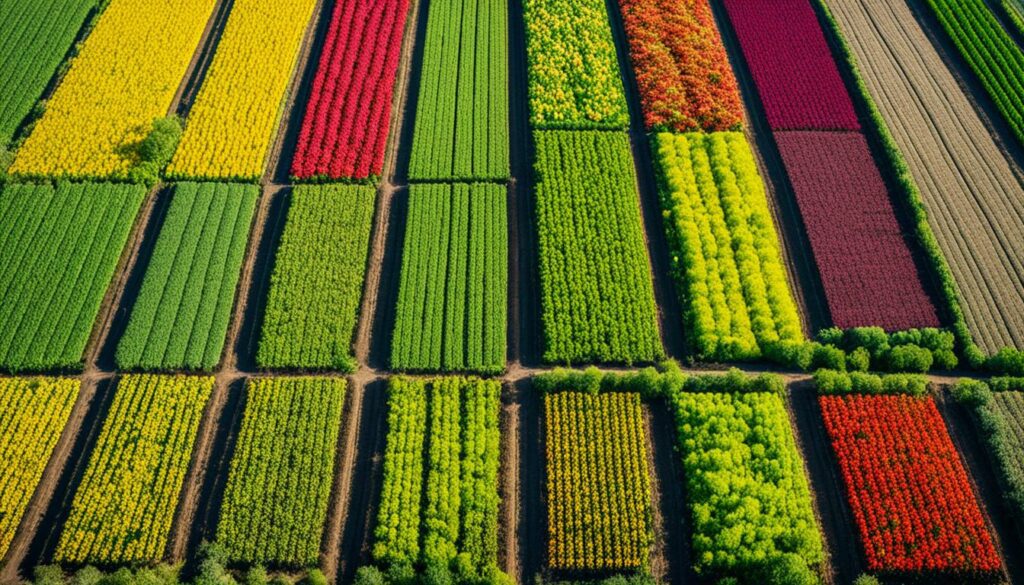
Leguminous crops are important in this. They can capture nitrogen from the air. This makes the soil better for other plants. It reduces the need for adding synthetic nitrogen. Using various crops together makes a strong environment for growing.
To care for the soil well, each crop’s needs must be considered. By planting different plants in sequence like legumes, cereals, and veggies, the soil gets various nutrients. Legumes bring natural nitrogen to the soil, cutting down on the needs for chemicals. This variety helps farming last longer.
Planning a good crop rotation takes thought. Usually, legumes start, to fix nitrogen. Then cereals follow, needing that nitrogen. Finally, deep-rooted vegetables can grow well. This cycle is good for the soil, fights pests naturally, and weeds. Here are some steps to follow:
This plan lets each crop use what the last crop left behind. It also makes the soil better each year. Cover crops can be used to fill gaps and help the soil stay healthy.
These steps lead to stronger, productive organic farms. This supports farming that lasts and helps the environment.
In the monoculture vs polyculture debate, the differences are striking. Monoculture means only one crop is grown on a field at a time. It can make a lot of rice or wheat quickly, but it uses a lot of chemicals. This harms the soil and the environment. Monoculture makes the soil lose its nutrients. It also uses more water and invites many pests.
On the other hand, polyculture systems mix different plants together. This way of farming is closer to how nature works. It includes methods such as having many crops in one field, planting one type of crop after another, growing different crops together, covering the soil with plants between seasons, and changing where crops are planted each year. These help the soil stay healthy and encourage a variety of life.
While both ways of farming need some chemicals, polyculture needs less. Because it uses fewer chemicals, the soil stays strong. Healthy soil means the plants can compete with each other. This makes the crops stronger and maybe even bigger. Polyculture is also good for the land in the long run. It reduces the need for harmful chemicals and makes sure there are many different plants and animals around.
Switching from monoculture to polycultural farming can do a lot of good. It’s a way to make farms both productive and good for the environment. This is vital for the future of our farms and the food we all eat.
Polyculture is good for the environment and lessens chemical use. Yet, it comes with its difficulties. It requires a lot of know-how and experience to manage many types of crops together. Farmers also need special tools to deal with these various plants.
Handling different crops at the same time is tough in polyculture. Farmers have to really understand what each plant needs and how they impact one another. Without this understanding, the results might not be as good as hoped.
Plants fighting for the same resources can be a problem. This fight includes light, nutrients, and water. In such cases, some plants may not grow as well as others, reducing overall harvests. Dealing with this competition needs a lot of effort and care, and it can be expensive too.
| Challenge | Details |
|---|---|
| Management Complexity | Requires extensive knowledge and specialised equipment. |
| Resource Competition | Light, nutrients, and water competition may lower yields. |
| Infrastructure Investment | High cost for managing diverse crop species. |
Polyculture is making a comeback in modern farming. It was once a key part of traditional agriculture. In the past, it supported a large portion of farmers in developing countries. These farmers grew many plants together, which was good for the land and their diets.
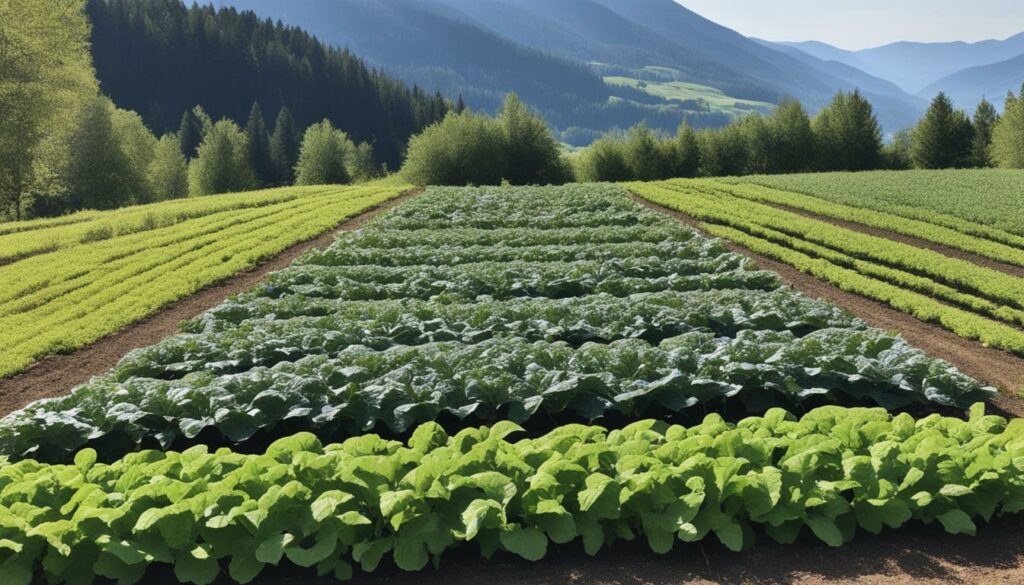
In the old days, farmers planted different crops close together. This helped fight pests naturally and kept their soil healthy. But, big farms in places like the United States moved to just growing one type of crop on a large scale. They used a lot of chemicals that harm the soil in the long run.
Today, farming is changing for the better by going back to polyculture. New ways of using technology and sustainable methods help save water. Farms can use almost half the water they used to without sacrificing crops. This is done by choosing the right plants together and watering them smartly.
Comparing old and new farming methods, there are clear benefits to the modern approach. Modern farms have more variety and use fewer harmful chemicals. They make more money per field and their soil is healthier. Farmers are happier with their work too because they get better results.
| Aspect | Traditional Agriculture | Modern Sustainable Farming |
|---|---|---|
| Plant Species Cultivated per Acre | 5-8 | 10-15 |
| Water Savings | Baseline | Up to 50% |
| Reduction in Synthetic Pesticide and Fertiliser Use | Baseline | Approximately 20% |
| Income Generated per Acre | $1,200 | $1,800 |
| Farmer Satisfaction Rates | 70% | 90% |
The return to polyculture in modern farming is promising. It combines old and new methods, benefiting both the environment and the economy. This approach is important for the future of farming worldwide.
Polyculture is a key part of eco-friendly farming practices. It means growing several different crops together. This method is good for the environment. It helps use fewer chemicals like pesticides, making farming more sustainable.
It also improves the health of the soil. By planting some crops together, they can help each other grow better. This means less need for artificial fertilisers and the soil can keep its goodness. Cover crops add to this by stopping the soil from washing away and keeping it moist.
Polyculture brings more life to the farm with different plants and animals. It helps keep bad bugs under control naturally. So, the farm is a more balanced and safe place for crops to grow. It also means a single disease or pest won’t ruin everything, unlike on farms that grow just one crop.
A big plus of polyculture is that it can save land and resources. It uses the ground better, so not as much water or chemicals are needed. This is great for growing healthy crops without harming the environment. It’s part of farming methods that aim for more natural farming.
| Aspect | Benefit |
|---|---|
| Reduced Pesticide Usage | Minimises the need for chemical pest control |
| Soil Conservation | Prevents erosion and retains moisture |
| Biodiversity | Supports diverse beneficial organisms |
| Resource Efficiency | Reduces need for complex irrigation and synthetic chemicals |
| Crop Resilience | Higher resistance to pests and diseases |
Polyculture is great for the planet. It improves farming today, so our farms keep being fruitful. This way, farmers can do their part in making a green and healthy world for all.
Polyculture farming mixes different crops to boost biodiversity. It creates homes for helpful insects and diverse soil life. This makes the environment healthier and farming more sustainable.
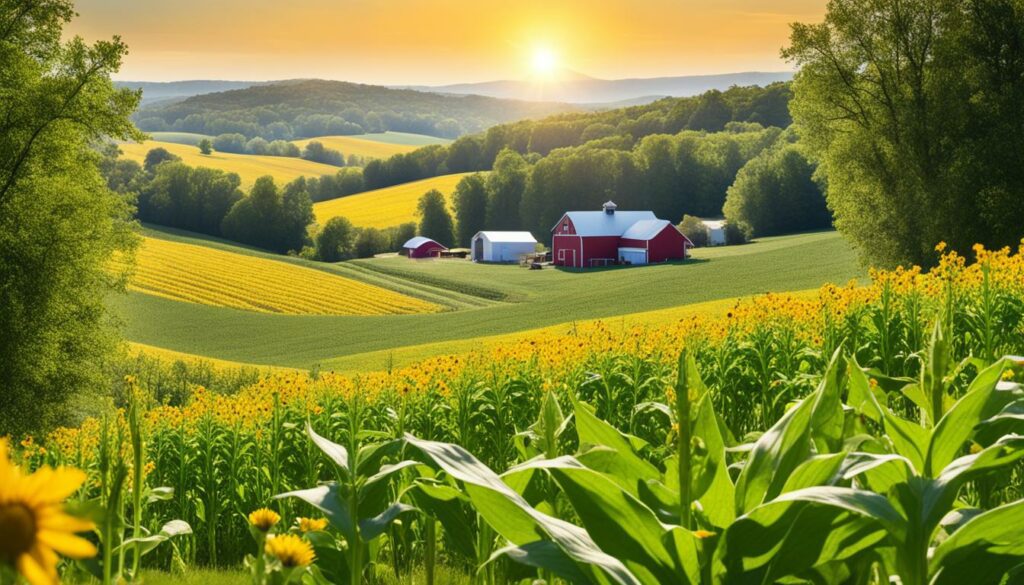
Polyculture attracts good bugs. These insects naturally control pests, lowering pesticide use. In small mixed farms, more bird types were found than in one-crop fields.
Dead oil palms also help more birds live there. But, too tall oil palms can actually reduce bird numbers.
Polyculture benefits the soil life too. Growing lots of different crops adds different types of food to the soil. This increases the activity of tiny life in the soil.
A large study in Malaysia showed that these methods help over 18,000 hectares of land. Polyculture supports a wider variety of life, which is good for the environment and agriculture.
Water management is key in polyculture systems, where different crops need various amounts of water. We use polyculture irrigation techniques to save water in farming. This works by carefully placing plants together.
The “Three Sisters” method is a good example. It involves planting corn, beans, and squash together. Corn grows tall, creating a structure for beans to climb. Squash plants cover the ground, keeping moisture in and slowing evaporation. This method helps keep water in the system for longer.
Plants with deep roots, like some legumes, find water from deep down. They help other plants with shallow roots save water. This approach creates a better environment that stops soil erosion and keeps soil moist. It shows why saving water in farming is so important.
Because different plants in polyculture systems need various amounts of water, they complement each other. This means less fighting for resources and more work done. Mixing planting methods saves water and boosts the health of soil and ecosystems.
Embracing polyculture in small areas like balconies or rooftops can do a lot. It can boost urban farming and help the environment. It means growing different plants close together.
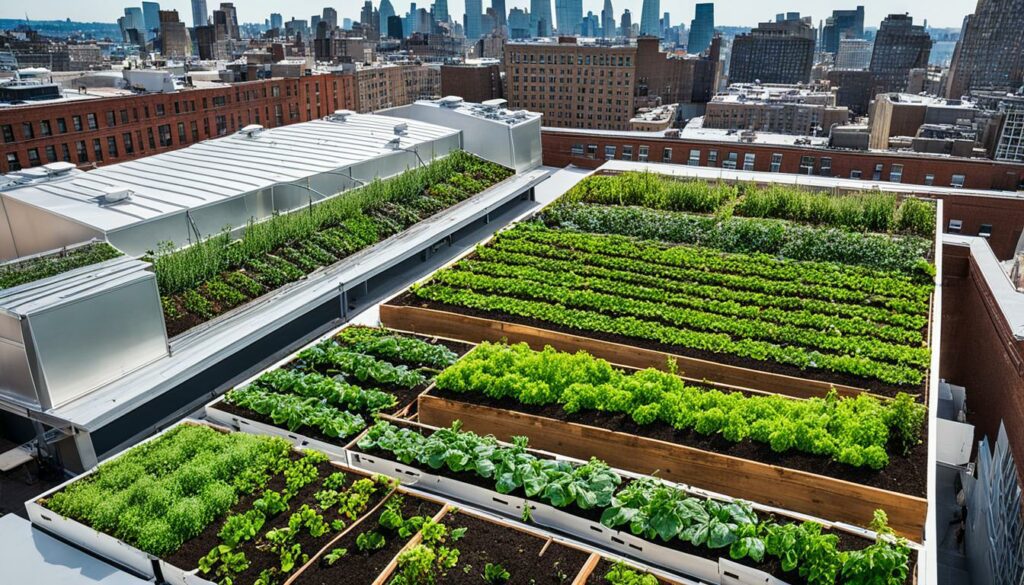
Gardening in cities needs smart ways to use little space. Methods like planting in stacks and pots work well. This way, you can grow a variety of plants even in a small area. These plants can help each other grow and fight off pests together.
Urban farming can do a lot with polyculture. It increases what you can grow in small areas and helps the environment. Farming this way can cool down cities, clean the air, and make more green places for people.
Here are some clever ways to farm in cities:
Using these methods, you can produce a lot more food than with regular farming. They also help fight off pests and save resources. Many farmers say it’s better than just growing one crop.
Making gardens in the city better might include high-tech watering and feeding. These can make urban farms more self-sufficient. This is good for people who want to grow their own food and help the planet.
Polyculture in small spaces helps not just with food but also with making friends. People in the city can work together to make more green areas. These places provide fresh air and beauty in the city.
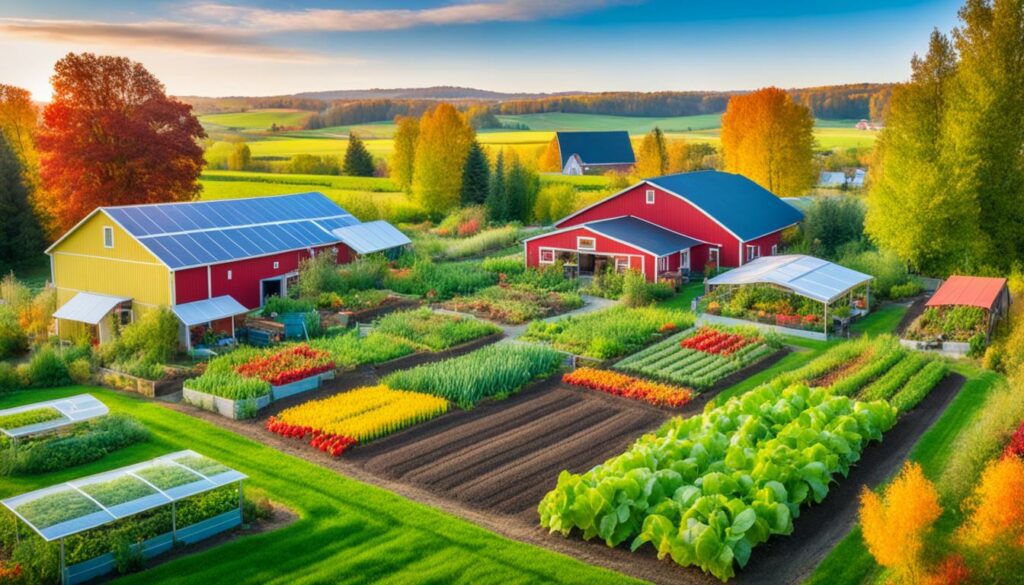
Polyculture farming boosts small farms by yielding more crops. Compared to big farms growing one crop, they produce 80% more food. This way, not only does the farm make more money, but it also offers a wider choice of fresh food to its area.
These farms often belong to families and help keep the local economy strong. Money stays within the community. This supports local shops and helps the area thrive. So, these types of farms are key for a place to be self-sufficient and full of life.
Polyculture farming needs more work, for example, attending carefully to weeding. However, it has big financial benefits. With tools like Farmbrite, farmers can plan and manage their fields better. This is vital for their success.
A study in Acre State showed that mixing crops like passion fruit and cassava helped both their yield and profit. It cut costs and made farms more money. This method was better for the land too, compared to just growing one plant.
In the Amazonia region, polyculture has shown it can lead to high produce. For example, cassava farming reached millions of tons. Even though some crops didn’t do as well, polyculture’s overall financial effect is strong for local areas.
| Crop | Annual Production (tons) | Yield (kg per hectare) |
|---|---|---|
| Cassava | 1,239,731 | 28,902 |
| Maize | 96,000 | 2,400 |
| Pineapple | 6,843 | 21,450 |
| Passion Fruit | 403 | 7,600 |
In summary, polyculture greatly improves the finances of small farms. By growing more than one crop and supporting local markets, it keeps communities strong. This method is both good for the environment and profitable for farmers.
The process for organic certification is tough. It ensures farm practices are good for the environment. A big part of this is following organic polyculture standards. These rules help farms have more types of plants and reduce the need for fake chemicals. Studies show organic farms, especially those with polyculture, have more life living in the soil.
Fifty-six studies looked at organic versus normal soils. They found organic soils had 32 to 84 percent more active life underground. It shows how good organic polyculture is for the whole environment. In Nicaragua, organic and traditional mixed farms had more kinds of birds compared to big, single crop farms.
Organic farms also use energy better and take care of resources well. In Turkey, organic apple farms used 30% renewable energy, while others used only 13%. They also made less pollution. This means organic farming is not only good for nature but also smart for business. It makes more money for farmers.
In the U.S., areas with a lot of organic farming saw people’s incomes go up by $2,000. Organic food is becoming more popular worldwide. This trend supports using polyculture in farming to get an organic certification.
| Aspect | Conventional Farming | Organic Polyculture |
|---|---|---|
| Biodiversity | Lower | Higher |
| Microbial Activity | Lower | 32-84% Higher |
| Energy Use (Renewable vs Conventional) | 13% Renewable | 30% Renewable |
| Greenhouse Gas Emissions | Higher | Lower |
| Economic Impact (Income Increase) | Stable | $2,000 Increase |
These results show that mixing different plants in farming, along with organic methods, is good. It meets the standards for organic certification. Plus, it helps the planet, makes more money, and benefits communities. Opting for eco-certification in farming by using polyculture is a wise choice today.
Exploring successful polyculture farms shows what can be achieved in sustainable agriculture. These stories from around the world offer a model for others to follow in farming.
The Land Life Company has planted millions of trees worldwide. This helps take carbon out of the air and improves the land. In Mexico, the Regeneration International Network is teaching farmers new ways to farm.
Dr. David Martinez’s work in the United States has shown the power of regenerative farming. It helps bring back bugs that help crops grow, making farms more productive.
The Svalbard Global Seed Vault protects seeds to keep our crops safe. In Zimbabwe, the Savory Institute makes dry lands green again. It helps plants and animals thrive while helping local people.
In Brazil, the ReNature project is making nature strong again. It uses trees and new planting to make more kinds of life. In Spain, Maria Ramirez has grown more food by using smart planting and saving water on her farm.
Over in Kenya, Dr. Wangari Maathai started the Green Belt Movement to plant trees. It fights tree loss and dry land, showing how regenerative farming can help a country. In China, John Liu has shown how farming can turn bad land into good and help many people.
In Indonesia, Siti Rahayu has helped women farmers to farm in ways that grow more food. This has made families more secure and the land stronger.
These stories show the great things that polyculture farms can do. They prove that these farming methods work and are important for the planet.
Polyculture systems are making a comeback as people see their importance for the future of farming. They let farmers grow many plant types together, improving the food we eat and the good plants do for our earth. Integrated Multi-Trophic Aquaculture (IMTA) is a key example after being studied for 25-30 years.
Perennial polycultures are especially impressive, providing more plant material and benefits to the land. By combining different grasses in pastures, they make the soil better, increase plant growth, and catch more nutrients. This also favours a wide range of tiny life forms which are essential for healthy ecosystems.
Polyculture helps the environment by increasing plant variety, which naturally keeps harmful bugs away. This makes farms less appealing to pests, reducing the need for pesticides. Mixing plants also helps save water and makes little weather zones that keep moisture in the soil. Cities and community gardens can greatly improve by using polyculture, making the air cleaner and boosting the happiness of the people who live there.
Choosing polyculture is a wise step towards farming that is good for nature and us. By carefully picking which plants to grow together, planning the farm well, and keeping it up, we support a farming future that lasts. Polyculture fits perfectly with preserving biodiversity, keeping the soil rich, and supporting the environment. It’s a practice we should all push for, to make sure our children get a planet that is strong and well.
Organic polyculture systems grow many crop types together. This mirrors natural ecosystems. By doing so, they boost biodiversity and allow for natural pest control. This makes the soil healthier as well.
Biodiversity farming attracts helpful wildlife. This forms a natural network to control pests. It also decreases the risk of large crop losses from diseases. The soil benefits from various plant interactions.
Polyculture interrupts the perfect home for pests by not having similar plants next to each other. This makes it harder for pests to grow in number. Good bugs and predators are attracted, naturally limiting the bad bugs. This then means fewer chemicals are needed to fight the pests.
Several methods are used. These include growing different crops together, planting some types after others, and specific plants next to each other to help each other grow. These methods increase the land’s output, support more wildlife, and make the soil richer.
Intercropping uses the land better by growing different crops at the same time. This method reduces the need for artificial fertilisers. It also makes the soil better, stops weeds from taking over, and helps different plants grow well together.
Cover crops protect and feed the soil. They stop the soil from getting washed away. They also help keep weeds down, keep the soil moist, and when turned back into the ground, make it more fertile and let air in better.
Changing what is planted each season keeps the soil rich and not just full of the same pests and diseases. A common rotation includes legumes, cereals, and vegetables, each type helping the next one grow better.
Instead of using chemicals, polyculture uses nature to make the soil strong and hardy. It also means there is no need for many pesticides. This kind of farming is good for the whole environment.
This type of farming takes more effort and understanding to make it work well. It might look like the plants are fighting for the same things but with good management, all can grow well together. It can also affect how many crops are grown and how much work is needed.
Old farming often used many plants together but new farming mostly used only one. However, more and more farmers are seeing the good things about having many plants together again. This means they are starting to use these methods to farm better.
Polyculture uses fewer chemicals and saves the soil, making it healthier. Because of this, less water is wasted, and the chance of all the crops dying is lower. It is a good all-around way to farm for the planet.
Lots of different plants mean lots of different insects and animals come too. This makes the whole farming area stronger and healthier. The soil is alive with good bacteria and other tiny creatures that help the plants grow.
Growing different crops that use water in different ways saves water. Some plants dig deep for water which means less is lost. Also, the way the plants are combined can help keep water where it is needed most.
Yes, it works well in small areas like urban gardens and on rooftops. It turns the city’s small places into green spots full of life. This not only helps wildlife but also makes the city a nicer place for people.
It makes small farms more successful by having a variety of quality foods. These farms then become trusted parts of the community, selling good food locally. This way of farming also helps keep local businesses going strong.
Polyculture’s natural way of farming meets the rules for being certified organic. This is because it uses nature, not chemicals, to keep the farm land healthy. Following these rules helps farms stay organic.
Many farms that grow a variety of plants together show great results. The land becomes healthier and richer. These success stories prove that farming in a natural way can be very effective. It encourages more farmers to follow suit.